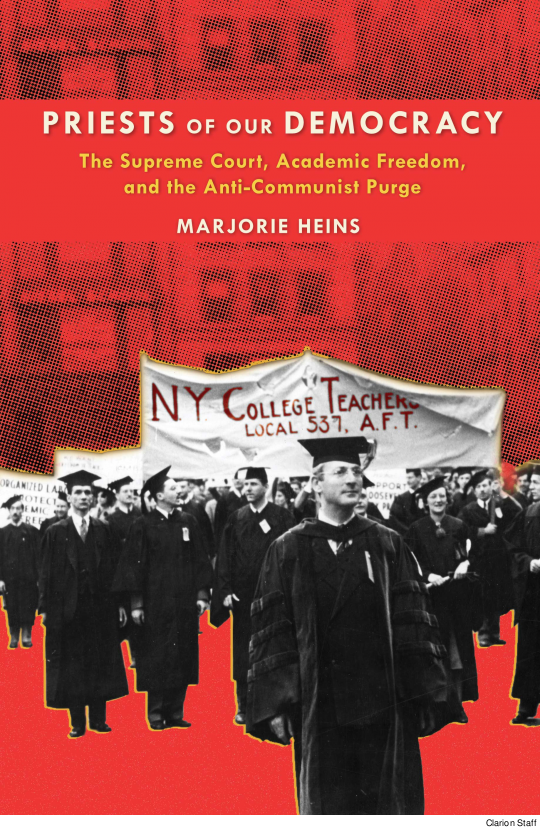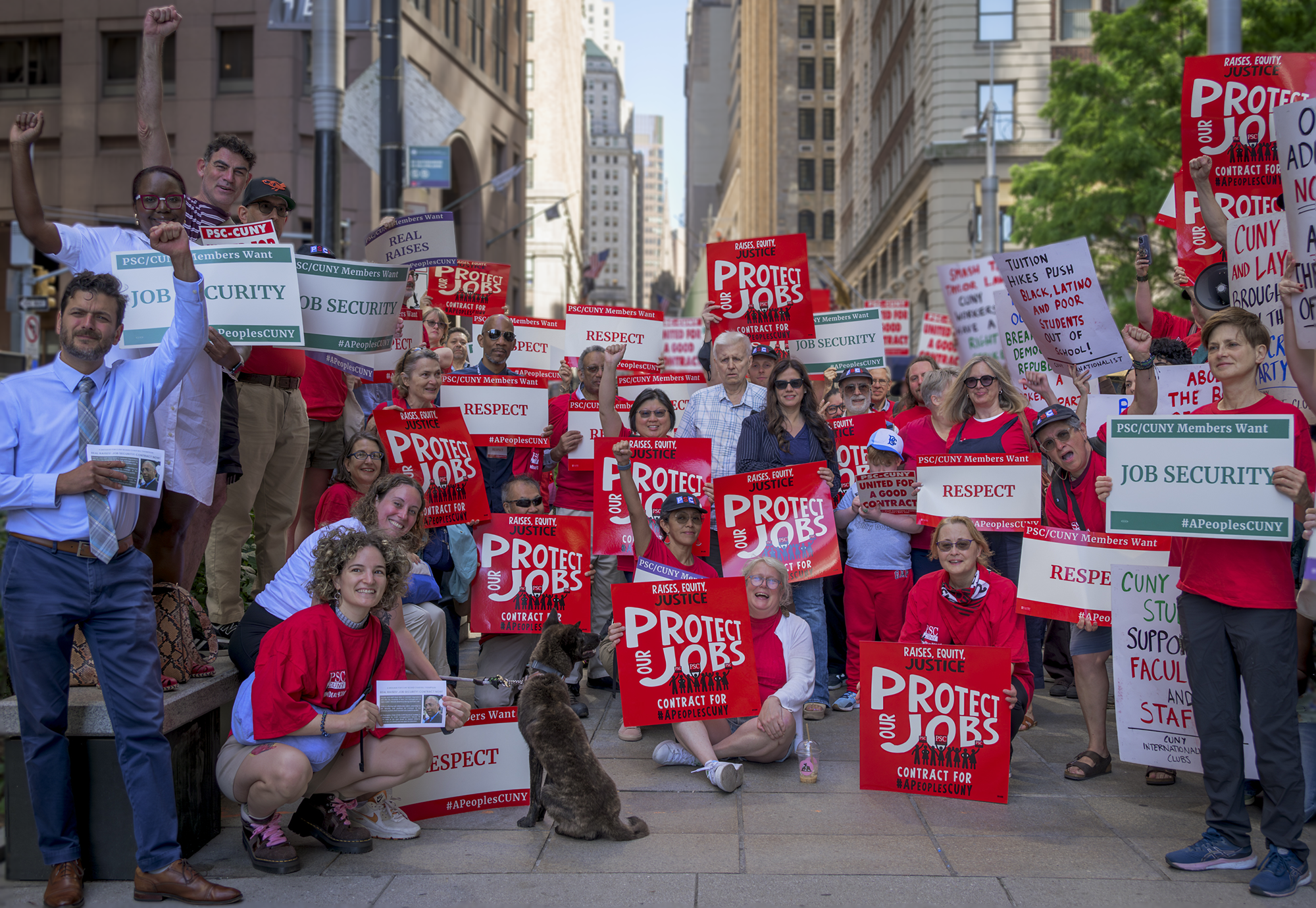Priests of Our Democracy: The Supreme Court, Academic Freedom, and the Anti-Communist Purge. By Marjorie Heins. New York University Press, 2013.
“If your dog had rabies you wouldn’t clap him into jail after he had bitten a number of persons,” New York State Senator Frederic Coudert, Jr., declared to a Republican women’s group in June 1941. “You’d put a bullet into his head, if you had that kind of iron in your blood. It is going to require brutal treatment to handle these teachers….”
Coudert was speaking about teachers in the city’s municipal colleges, and especially about those active in the New York College Teachers Union, AFT Local 537. By the end of the year, the senator showed just how much iron he had in his blood, as he carried out a purge of educators that presaged the Cold War repression of the Left.
We like to think that this period, when over 50 faculty and staff at City College alone lost their jobs, and the Cold War investigating committees and loyalty oaths that followed, are over. But are teachers safe today, secure in the belief that their academic freedom protects them in their professional lives? Marjorie Heins’s book, Priests of Our Democracy, will make you think again.
The book’s title is taken from a decision by Justice Felix Frankfurter (City College Class of 1902) in a 1952 test case on an Oklahoma loyalty oath, in which he described teachers as “the priests of our democracy.” Democracy, Frankfurter wrote, depends on “disciplined and responsible public opinion,” which in turn demands that teachers be free “to do their jobs.” The following year, Chief Justice Earl Warren wrote of “the vital role in a democracy that is played by those who guide and train our youth….”

Loyalty Oaths
While Cold War anti-communism targeted all public workers, it was the teachers who were most often suspect. Frankfurter’s comment suggested a central reason they were suspect, one that resonates with attacks on teachers in the past decade with its War on Terror.
More than a century ago, with the rise of the modern university, came the first high-profile academic freedom cases. All turned on economic and labor issues: the first to be fired in the 1890s and 1900s were labor economists whose views offended businessmen and politicians.
In New York, the search for subversive teachers began with the infamous but short-lived Lusk Laws of 1921, demanding a loyalty oath for schoolteachers. Requiring public school and college teachers to sign loyalty oaths as a condition of their employment became common across the country. In New York, the Ives Loyalty Oath Law was imposed in 1934, and at least 22 states had such laws on the books by 1936.
The country’s most effective purge prior to the Cold War was that of New York’s Rapp-Coudert Committee, 1940-42. Its investigators began by subpoenaing the membership lists of the New York Teachers Union, AFT Local 5, as well as the College Teachers Union, which had won its own AFT charter in 1938. The union membership lists then served as the road map for the investigation.
In her detailed and well-researched book, Heins explains how that purge and subsequent investigations by federal committees led to dismissals of faculty members under the State’s 1949 Feinberg Law and Section 903 of the NY City Charter, damaging first the public colleges and then the public schools.
Coudert’s Red purge stemmed from a 1935 election in the Teachers Union that ousted the longtime Socialist leadership in favor of a rank-and-file coalition that included some Communists. The ousted leaders left the union, cooperated with the investigating committee and pressed the AFT to strip the Teachers and College Teachers Unions of their charters, finally succeeding in 1941. They were joined by philosophers Sidney Hook and John Dewey, liberals who saw the urgent need to rid the schools of “Red” teachers in thrall to a foreign ideology. Hook readily offered investigators the names of union members he suspected. The Teachers Union continued valiantly on for another 13 years as a CIO union.
Judicial Precedent
In her largely sympathetic account, Heins says she strived for a “balanced” view of the Red scare, trying to distinguish between the leftism of the victims and liberalism. The author is troubled by the Communist Party’s secrecy and particularly by the ways some suspects tried to survive the hearings. If they refused to name names, subpoenaed teachers faced firing whether they confessed to party membership or not: in the Rapp-Coudert hearings, they couldn’t plead the First or the Fifth Amendment. Times were tough when the purges started and most of them had families to support. As important, very few were willing to sacrifice their colleagues as the price for saving their own skins.
Heins is troubled by those who perjured themselves. The party’s secrecy, and the evasiveness of those hauled before investigating committees, didn’t win much public sympathy. Had the party taken the credit it often deserved for being in the forefront of progressive trade unionism, the struggle for civil rights, and anti-fascism, the public might have seen the subsequent purges differently. But this was not a decision many of the individuals in these sad accounts could have made.
While many academics might see academic freedom as grounded in the Bill of Rights, Heins reminds us that the Supreme Court’s jurisprudence is less than reassuring on this point. The greatest significance of her book lies in her careful unraveling of the court’s rulings on issues of academic freedom, most of them in postwar Red Scare cases –and many involving faculty at colleges that are part of CUNY today.
Many of the Court’s early decisions in academic freedom cases relied on Justice Oliver Wendell Holmes’s 1892 statement that a public employee “may have a constitutional right to talk politics, but he has no constitutional right to be a policeman.” As Heins points out, this ruling ignores the vital issue of the government’s power to demand the renunciation of constitutional rights as a condition of employment. Teachers and other public employees who refused to answer questions on Fifth Amendment grounds were called “Fifth Amendment Communists,” and deemed to be without a constitutional right to their jobs.
The Court began to rule differently in the 1950s, after Earl Warren’s appointment as Chief Justice. The first case to undermine the anti-communist teacher purges involved Harry Slochower at Brooklyn College. Identified by the Rapp-Coudert committee in 1941, Slochower had escaped dismissal for lack of corroborating witnesses. The Senate Internal Security Subcommittee began subpoenaing teachers in this situation at its 1952 hearings in New York. Although Slochower then testified about his party membership during the previous 11 years, he refused to talk about his membership prior to that time, invoking the Fifth Amendment.
Within days, the Board of Higher Education (BHE) suspended Slochower without pay, along with Vera Shlakman of Queens College and Bernard Riess of Hunter. Under Section 903 of the City Charter, all three faculty members were summarily dismissed without a hearing or trial for refusing to answer the committee’s questions.
In 1956 the Court struck down Slochower’s dismissal on narrow due-process grounds. Only hours later, Brooklyn College President Harry Gideonse brought new charges of “conduct unbecoming,” and Slochower resigned rather than suffer another BHE trial.
A year later, in Sweezy v. New Hampshire, the Court ruled against the state attorney general’s attempt to make Paul Sweezy’s “private life a matter of public record” in a broad investigation into what the Court saw as “such highly sensitive areas as freedom of speech or press, freedom of political association, and freedom of communication of ideas, particularly in the academic community.” Once again, the Court’s decision rested on due-process grounds. But Warren added an academic freedom concern, writing that “scholarship cannot flourish in an atmosphere of suspicion and distrust.”
In a concurring opinion, Justice Frankfurter tried to make academic freedom the pivot on which the case turned, referring to a group of South African scholars’ plea for respecting the “four essential freedoms of a university – to determine for itself on academic grounds who may teach, what may be taught, how it shall be taught, and who may be admitted to study.” Unfortunately, as Heins so aptly puts it, Frankfurter saw this in terms of the university as a whole, without distinguishing between the interests of the institution and those “of the scholars who do the crucial intellectual work.” This has remained a point of contention, affecting issues from faculty members’ union rights to the scope of academic freedom for adjuncts.
The Court’s most important decision came in 1967 in the case of Harry Keyishian and others. A young English instructor at SUNY Buffalo, Keyishian refused to sign the certificate attesting that he wasn’t a Communist demanded by the Board of Trustees as a condition of employment under the Feinberg Law. Keyishian had been a student at Queens College when Oscar Shaftel and Vera Shlakman were suddenly dismissed in 1952. In striking down the Feinberg Law, Justice William Brennan wrote that: “Our nation is deeply committed to safeguarding academic freedom, which is of transcendent value to all of us and not merely to the teachers concerned. That freedom is therefore a special concern of the First Amendment, which does not tolerate laws that cast a pall of orthodoxy over the classroom.”
The Keyishian case stripped public officials and education boards of the means used to root out teachers accused of subversion. Now vindicated, New York’s schoolteachers and professors sought reinstatement or pension benefits. But the city and the BHE delayed for years. As one of them saw it, more important than pensions was the loss of “378 of [the city’s] best teachers during a critical time when these teachers were badly needed…. [They were the ones who had] succeeded in building a bridge between the school and the community.”
Damage Done
Heins readily acknowledges the tragic consequences of the purges, not only for the individuals, but for all in narrowing our political discourse, and in the demise of the New York Teachers Union in 1964, the Rapp-Coudert Committee’s original target in 1940. Lamenting the destruction of “the bridge between the school and the community,” she concluded that “The union’s advocacy for minority children, for decent facilities, and against racism was history by the time desegregation battles tore apart the school system in the late 1960s and early ’70s. …[H]ad this remarkable union not been destroyed, the subsequent race wars in the schools of New York City might have been avoided.”
This is an important and valuable book for anyone interested in the Constitutional dimension of the anti-communism that erupted in the mid-20th century, and which wreaked so much damage on US schools, colleges and unions. Marjorie Heins has done a remarkable job.
______________________________
A longer version of this article originally appeared in Working USA (Vol. 16, No. 3). More information at tinyurl.com/Working-USA-Leberstein-Heins.

